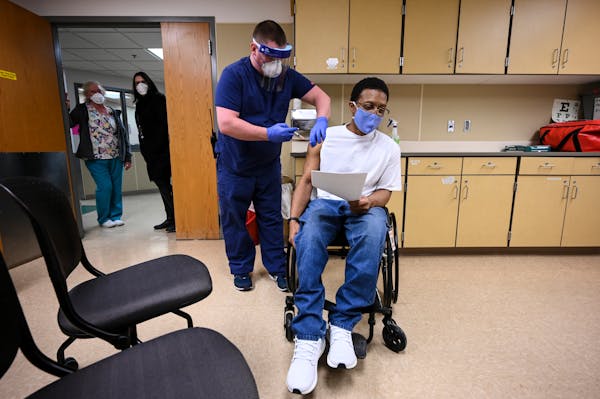More than 84,000 people as of Tuesday morning had received first doses of COVID-19 vaccine in Minnesota, amid a pandemic that has caused 5,461 deaths and 425,261 diagnosed infections in the state.
The COVID-19 totals include 18 deaths and 1,612 infections newly reported Tuesday by the Minnesota Department of Health.
State health officials said they were encouraged by the recent declines in COVID-19 activity in Minnesota and steady deliveries of vaccine. Minnesota has received 297,350 first doses of the two-dose COVID-19 vaccines made by Pfizer and Moderna, and expects another 66,000 doses this week.
State infectious disease director Kris Ehresmann said it was remarkable that multiple vaccines have been developed, approved and delivered against a novel coronavirus that was identified only a year ago.
"It's time that we celebrate how far we've come in a very short amount of time," Ehresmann said.
Second doses are starting to arrive in Minnesota as well for injection three to four weeks after the first doses. The Minneapolis VA Medical Center provided second doses to workers starting Monday.
State officials reported Tuesday that 80,857 first doses of vaccine had been administered to the high-priority groups of health care workers and long-term care residents, the latter being at increased risk for severe COVID-19 due to their ages and underlying health problems.
That total doesn't include several thousand doses delivered separately in Minnesota to federal sites such as the Minneapolis VA and the Indian Health Service in Bemidji. The VA through Monday had reported providing 3,125 first doses to workers and veterans, and 102 second doses.
Ehresmann said Minnesota already has enough doses in hand to provide first injections to those health care providers most at-risk, who work in COVID-19 units or emergency departments. The state is on track to vaccinate all health care workers and long-term care residents by month's end, she added.
The Minnesota COVID-19 Vaccine Allocation Advisory Group is seeking public comment through Thursday and is scheduled to meet Monday to discuss the vaccination of the second priority group: people 75 and older, and workers such as teachers, police officers and power plant workers in front-line essential industries.
Pandemic indicators have continued to improve in Minnesota, following a wave that emerged in the Upper Midwest this fall and then spread to the rest of the country.
The state on Tuesday reported that 155 people with COVID-19 were admitted to intensive care beds in Minnesota hospitals, the lowest number since late October and a dramatic decline from a peak of 399 patients on Dec. 1.
State health officials remained cautious and concerned that gatherings over the holidays could have fueled an increase in viral transmission. The positivity rate of COVID-19 diagnostic testing had briefly dropped on Dec. 24 below the state warning threshold of 5%, but jumped up to 6.3% on Dec. 27.
A similar uptick occurred over the Thanksgiving holiday week. Both increases could have been due to decreased testing activity during those holiday weeks, but might also reflect increased viral transmission.
Health officials urged people to continue to wear masks in public, practice social distancing and avoid large gatherings. Indoor service remains closed at bars and restaurants through Jan. 10, but Gov. Tim Walz is scheduled Wednesday to announce a loosening of those restrictions.
Jeremy Olson • 612-673-7744

'He was about community': Scores memorialize north Minneapolis entrepreneur Sammy McDowell
Deadly shove at assisted-living center in Hugo investigated as homicide

Lack of volunteers forcing longtime Braille service to close
Two stalled Duluth housing projects move ahead

